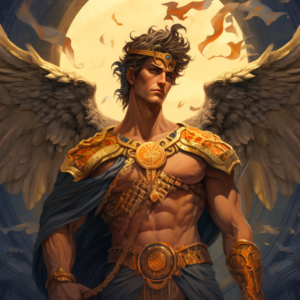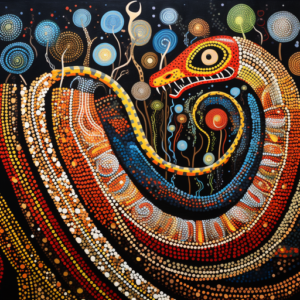Julunggul, also known as the Rainbow Serpent or the Serpent Mother, holds a significant place in the mythologies of various Aboriginal cultures in Australia. Regarded as a primordial being, Julunggul is believed to have existed since the Dreamtime, the ancient period of creation. She is considered a creator deity associated with fertility, water, and the cycles of life.
Appearance
Depictions of Julunggul vary across different Aboriginal traditions, but she is commonly represented as a giant serpent with a vibrant and multicolored body. Her scales shimmer with iridescent hues, resembling the colors of the rainbow. Julunggul is often depicted with a long and powerful body, symbolizing her connection to water and the flowing currents of life.
Powers & Duties
As the Serpent Mother, Julunggul possesses immense powers related to creation, fertility, and the natural world. She is believed to have the ability to shape and reshape the land, rivers, and waterways. Julunggul’s presence is associated with the replenishment of water sources, the growth of vegetation, and the overall harmony and balance of ecosystems.
Family
In Aboriginal mythology, Julunggul is often considered a mother figure and a creator of life. She is sometimes associated with the Wawalag Sisters, who represent fertility and initiation rituals. Julunggul’s family connections vary among different Aboriginal cultures, but she is frequently depicted as a mother to other important ancestral figures and deities.
In Yolngu mythology, the Wawalag Sisters are associated with the initiation rituals and the passing down of cultural knowledge from one generation to the next. They are revered as guardians of sacred women’s ceremonies, which are central to Yolngu culture and identity.
Symbols
Julunggul is closely associated with several symbols that embody her significance and influence. The rainbow is one of the most prominent symbols, representing her connection to the celestial realms and the diverse colors of the natural world. The serpent itself is a powerful symbol of transformation, renewal, and primal energy. Other symbols associated with Julunggul include water, rain, and the life-giving properties of the Earth.
Worship
Worship of Julunggul often involves rituals that celebrate the cycles of life, water, and fertility. Aboriginal communities engage in ceremonies, dances, and songs to honor her power and seek her blessings. Offerings are made to ensure the continued abundance of water and sustenance for the people and the land. These rituals also serve to maintain a harmonious relationship with the natural world.
Facts About Julunggul
- Julunggul is often associated with sacred waterholes, lakes, and rivers, believed to be her dwelling places.
- She is revered as a protector of women’s fertility and childbirth, and her presence is sought during pregnancy and childbirth rituals.
- The serpentine motion of Julunggul is believed to be responsible for the creation of river bends and meandering waterways.
- In some Aboriginal traditions, Julunggul is regarded as a guardian of sacred knowledge, passing down wisdom and teachings to the people.
- The stories of Julunggul vary among Aboriginal cultures, reflecting the diverse interpretations and regional variations found throughout Australia.






